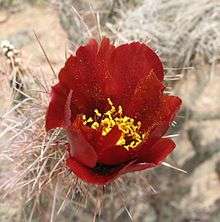Cylindropuntia acanthocarpa
Cylindropuntia acanthocarpa, commonly referred to as buckhorn cholla, is a cholla native to the Mojave, Sonoran, and Colorado Deserts of North America. Along with Cylindropuntia bigelovii (the "teddy bear" cholla), it is the most common cholla found in these deserts.
| Cylindropuntia acanthocarpa | |
|---|---|
| Scientific classification | |
| Kingdom: | Plantae |
| Clade: | Tracheophytes |
| Clade: | Angiosperms |
| Clade: | Eudicots |
| Order: | Caryophyllales |
| Family: | Cactaceae |
| Genus: | Cylindropuntia |
| Species: | C. acanthocarpa |
| Binomial name | |
| Cylindropuntia acanthocarpa | |
| Synonyms | |
|
Opuntia acanthocarpa | |
Varieties

Flower
During winter dryness.
There are a number of recognized varieties include:
- Cylindropuntia acanthocarpa var. acanthocarpa [1]
- Cylindropuntia acanthocarpa var. coloradensis — L.D. Benson; Colorado buckhorn cholla.[2]
- Cylindropuntia acanthocarpa var. ganderi — (C.B. Wolf) L.D. Benson
- Cylindropuntia acanthocarpa var. major — Engelm. & J.M. Bigelow [3]
- Cylindropuntia acanthocarpa var. ramosa — Peebles
- Cylindropuntia acanthocarpa var. thornberi — (Thornber & Bonker) L.D. Benson; Thornber's buckhorn cholla.[4]
Ethnobotany
- Early spring was called ko’oak macat (the painful moon) by the Tohono O’odham because of scarce food supplies. During this season, they turned to cacti for food and pit-roasted thousands of calcium-rich cholla flower buds.
- Today's O’odham people still pit-roast or boil the cholla buds, which taste like asparagus tips.
References
External links
- Cylindropuntia acantocarpa photo gallery at Opuntia Web
- Calflora Database: Cylindropuntia acanthocarpa (buck horn cholla)
| Wikimedia Commons has media related to Cylindropuntia acanthocarpa. |
This article is issued from Wikipedia. The text is licensed under Creative Commons - Attribution - Sharealike. Additional terms may apply for the media files.